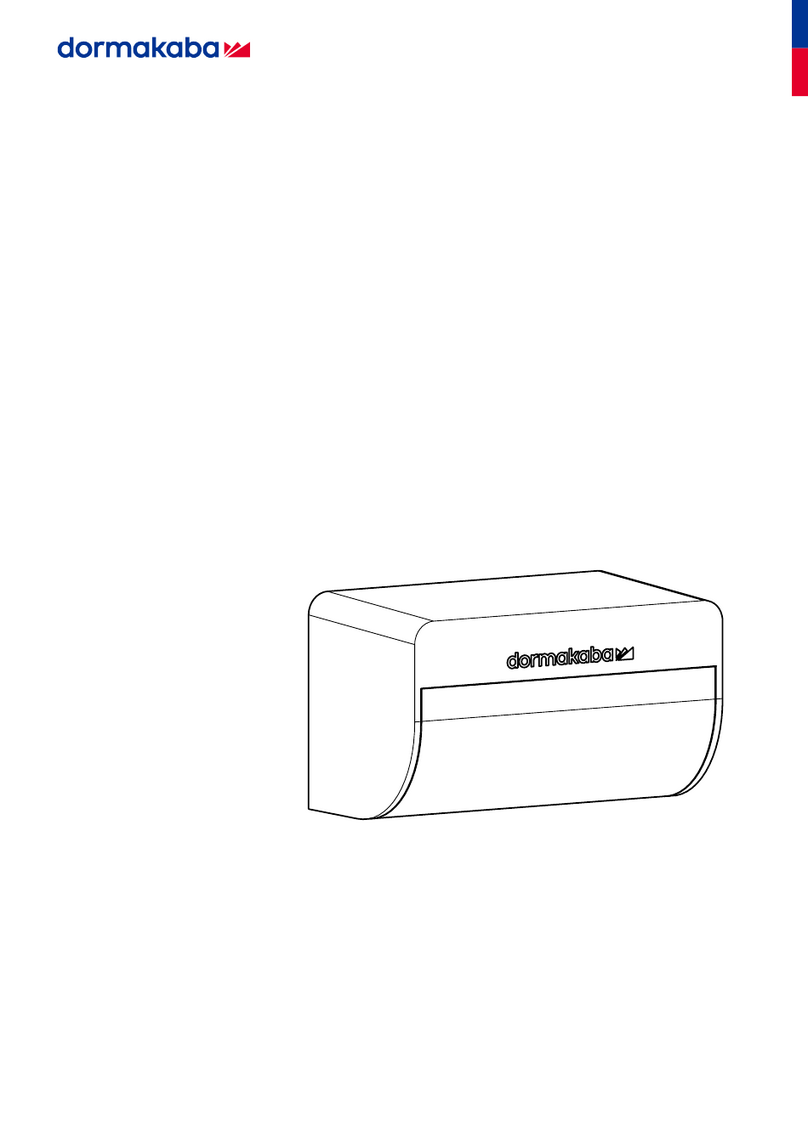
Radarsensor M A01
2/8 060616 45532/16707 - 2023-04
Montage
Montagepositionen ermitteln
1. Die Montagepositionen auf der Band- und Bandgegenseite mit-
tig über der Tür ermitteln.
2. Die Installationshöhen gemäß der Tabelle einhalten.
3. Die Abschattung des Sensors durch den ED-Antrieb vermeiden.
Kenngröße Wert
1 Installationshöhe vom Boden 2,0 m bis 4,0 m
2 Installationshöhe über Ober-
kante des Türflügels, bei
mittiger Montage über der
Tür (empfohlen)
0,2 m bis 0,5 m
3 Montagepositionen (emp-
fohlen)
• Verschiebung von maxi-
mal 0,8 m aus der Mitte
nach rechts und links
zulässig
• bei 1-flügeligen Türen:
optimale Position genau
mittig über dem Türflü-
gel
• bei 2-flügeligen Türen:
optimale Position genau
mittig über beiden
Türflügeln,
4 Optionale Montagepositio-
nen
• Optional ist die Monta-
ge auf Antriebshöhe
über den Bändern er-
laubt (gilt für 1- und 2-
flügeligen Türen). Bei 2-
flügeligen Türen vor-
zugsweise am Gangflü-
gel (G).
DIP-Schalter einstellen
dormakaba empfiehlt, den DIP-Schalter einzustellen, bevor der
Sensor an der Wand montiert wird.
Wenn die Stellung der DIP-Schalter verändert wird, einen CAN-
Reset (Cr) durchführen und den Wert auf "1" setzen.
üACHTUNGESD-Schutzmaßnahmen beachten.
1. Am DIP-Schalter (2) auf der Radarplatine (1) die ON- oder OFF-
Positionen einstellen. Siehe untere Tabelle.
2. Die Einstellungen für die DIP-Schalter 1 und 2 gemäß Position
des Sensors an der Tür ausführen.
3. Bei dem letzen Teilnehmer der Reihe den DIP-Schalter 4 im Be-
trieb auf ON/"Abschlusswiderstand für CAN aktiv" einstellen.
DIP ON OFF
1 Außenmelder Innenmelder
2 Bandgegenseite Bandseite
3 Option Option
4 Abschlusswiderstand
für CAN aktiv
Abschlusswiderstand
für CAN inaktiv
Sensor montieren
1. An geeigneter Stelle einen Wanddurchbruch setzen, wenn dies
erforderlich ist.
2. Das Lochbild für den Sensor setzen.
3. Bei 2-flügeligen Türen den Gangflügel-Antrieb festlegen.
4. Die ED-Anschlussplatine-CAN im Gangflügel-Antrieb montieren.
5. Den Sensor an der Wand montieren.
6. Den Neigungswinkel des Sensors von Hand in 15°- Schritten ge-
mäß der unteren Tabelle einstellen.
7. Den Sensor anschließen. Dabei die Klemmbelegung der ED-An-
schlussplatine-CAN beachten.
Neigungswinkel in Abhängigkeit zur Montagehöhe
Montagehöhen
Neigungswinkel 2,0 2,5 3,0 3,5 4,0
30° x x
45° x x x
(x = Kombination empfohlen)
Für Zwischenhöhen an dem Neigungswinkel aus der nächsthö-
heren oder tieferen Montagehöhe in der Tabelle orientieren.
In Sonderfällen kann von der empfohlenen Winkeleinstellung
abgewichen werden (z. B. Wand im Erfassungsbereich).
Inbetriebnahme
ED-Parameter für Betrieb mit Radarsensoren
einstellen
Die Parameter über das Handheld oder über die Bedienschnittstelle
des EDs einstellen. Im Handheld sind die Parameter im Menü "Son-
derfunktionen" zu finden.
Parameter dd
Mit dem CAN-Reset wird die Offenhaltezeit automatisch auf "0" ge-
setzt, wenn mindestens 1 Radarsensor M A01 angeschlossen ist.
Wenn gewünscht, kann der Parameter nach dem CAN-Reset verän-
dert werden.
Parameter Ih und Ah
Die Montagehöhen Ih und Ah einstellen.
Parameter IT und AT
Wenn die Parameter kleiner gewählt werden, den negativen Einfluss
auf die Ausblendung von Querverkehr beachten. Das Türöffnungs-
verhalten wird generell empfindlicher.
ED-Parameter So
Der Parameter So Öffnungsgeschwindigkeit der Tür hat Auswirkun-
gen auf den generellen Öffnungszeitpunkt der Tür. Fährt die Tür nur
langsam auf, dann öffnet sie eher. Fährt sie schneller auf, dann öff-
net sie später.
Parame-
ter
(Hand-
held Klar-
text)
An-
zei-
ge
min.
Wert
max.
Wert
Stan-
dard
Bemerkungen
Innenmel-
der Mon-
tagehöhe
(MA01 IM
Height)
20 40 25 Montagehöhe des
Innenmelders indm
Außen-
melder
Montage-
höhe
(MA01 AM
Height)
20 40 25 Montagehöhe des
Außenmelders indm
Innenmel-
der Quer-
verkehr-
Mode
(MA01 IM
QV)
0 3 0 0 - Querverkehr links
und rechts ausblen-
den (Standard)
1 - Querverkehr
rechts erfassen
2 - Querverkehr links
erfassen
3 - Beide Seiten er-
fassen
Außen-
melder
Querver-
kehr-Mo-
de
(MA01 AM
QV)
0 3 0 0 - Querverkehr links
und rechts ausblen-
den (Standard)
1 - Querverkehr
rechts erfassen
2 - Querverkehr links


























